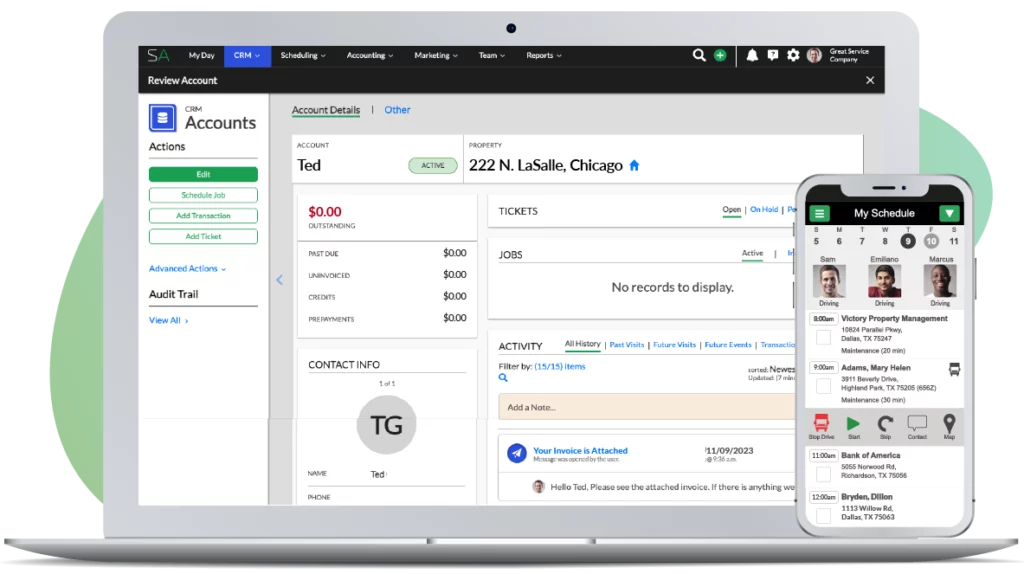Jonathan:
Hey. I get asked all the time, “What’s wrong with my business? Can you take a look at my financials? Can you help me understand what’s going on in my business?”
First place to always start is to look at labor. You can scan the P&L, or I’d scan your P&L, but I’m going to zero in on your labor because it’s the 80/20 of your financial situation. It is and will always be the biggest expense in your business. I’d drop some notes on my screen here so you can just follow along, and also to prompt my memory because I wanted to talk about this. I’ll try to keep it pretty quick.
But if you’re trying to fix your business, first thing to look at is labor. It’s the area that you want to always be working to drive down, meaning you want to be working to reduce your labor expense. I’ve got three categories. This is not fully inclusive or exhaustive, meaning there’s a whole lot of other stuff you could be doing, but if you just say, “Hey, what’s the low-hanging fruit, what’s the most common offender?” I put some of those down on my screen so you can see them. Let’s talk through them.
I’d start with trucks and equipment. Looking at your trucks, looking at any individual piece of equipment, is that truck, is that piece of equipment breaking down? Are you constantly having to repair it? Is it constantly out of commission? Is it constantly in the shop? Not only is that costing you money in terms of parts and maintenance and such, it’s costing you labor in that you’re not producing all your work, you’re not getting to all the client jobs. If you bill the client for work performed, meaning they’re not under contract, and you don’t get out to take care of a piece of work this week because your truck was broken, you’ll never earn that revenue back. That revenue’s gone.
For example, if you miss one of your lawn-mowings, and it’s $50 a visit, you’ll never get that $50 back because you missed that mowing. That breakdown cost you that. It cost you the $50, not to mention, if you have team members on your payroll sitting in that truck when the truck’s broken or when they’re waiting to work, if you’re still paying them, that’s costing you money, so you want to really be looking close at any breakdowns, any downtime on your trucks and equipment.
You want to then be looking at training or misuse. Do you need to do some training on a piece of equipment? For example, let’s say you’re running larger equipment, like a walk-behind behind, and there’s challenges adjusting the deck or the team doesn’t know when to use a piece of equipment, meaning they’re using the wrong size equipment on the wrong properties or on certain properties, or they’re using the wrong size equipment on certain parts of the properties, and it’s creating lots of inefficiencies.
Yes, they could mow with the 61 inch mower, but they’re mowing such a small spot, they’d be better off with a 61 inch walk-behind or a 21 inch mower. Yes, it’s a smaller deck, but when you track the time, it actually gets the job done faster and the job done better. You’re looking for all of those inefficiencies. Start with equipment and trucks. You don’t have to start there, but that’s one area to look at. I see it constantly, especially with younger businesses that don’t have a lot of money, and so understandably, they’re having to cut corners on their trucks and equipment, but it could be costing you dearly.
From there, move into looking at labor utilization. Now we’re talking about think about the team on your payroll, whether it be in the office, whether it be in the field, whomever it is, for each individual, how is time being wasted throughout their day? A great example is, you’ve got cell phones. Did you cut corners to use a cheapie Android phone, and the reason I pick on Androids is because you can buy some really inexpensive phones that run the Android operating system that are unbelievably slow, so if you’re running software on that device, it’s just such a crummy piece of hardware that whatever the softwares you’re running, it’s going to be really slow.
Or they constantly have problems talking on the phone or browsing the Internet or checking email, whatever it is you need them to do. Well, you can get better labor utilization by spending a little bit extra money now, so spending more money upfront to better utilize their time because payroll’s expensive later.
What about computers? Do you have them on slow computers? Do you have them on poor quality computers? Same scenario as a phone. Crummy computers are going to run the software, whatever you’re running, slower. They’re going to, if they’re working inside Google Docs or whatever the case may be, it’s not going to be as good. It’s not going to be as fast. Then think about the software that you’re buying and using. It is bringing efficiencies to the business or not? A really good software system should bring you a lot of efficiencies.
Also think about automation. You might’ve thought about, I don’t know, you may or may not know much about automation, but everything’s changing. There’s a ton of automation solutions out there, technology solutions that you can go and buy and/or tools that you can use. For example, if you need to send out reminders to clients via email, there’s more and more tools where you can automate sending out that email, and you don’t even … You set it up once and forget about it. There’s tools and solutions out there that you can get that will connect different software systems together to help automate activities.
Really, have a new look at automation technology because it can eliminate a number of things that your team might have to do manually that you’re paying them an hourly rate to do. It may reduce how soon you have to hire that next person. Automation is in everything from phone systems to software technology to all varieties of, all types of areas of your business. Just take a look at automation as well. I know I’m going through this fast, but the point is I just want you to get it thinking about a few things.
Then if you want to look for just simple top offenders, the most common offenders you’ll see inside a company where labor’s being wasted, I’d recommend you go out in the field, like literally go out in the field, watch the crews, watch the techs work, track their time. They should be tracking their own time, but track their time from the minute they arrive at the property to the minute they leave. There’s a lot of software solutions now that have mobile devices where you can clock in and out. Of course, Service Autopilot does that, but track the time.
If you don’t have any of that, fine, write it down on paper. When they turn off the ignition, write down the start time. When they get back in the truck and turn on the ignition to leave, write down the stop time. Track that for all your properties. Look for inefficiencies, but also get out in the field and watch what they’re doing because then you’ll spot what the issue is. Is it a particular person on the crew? Is it the whole team, or is it when I have these individuals working together? They’re just not efficient? What is the problem? When you see it, you’ll be able to fix it. That’s one thing to look at that’s a top offender.
Look at drive time. You have too much density, or you have too little density in your route. Your route is spread out. You’re driving from one place to the next. The crew’s not driving an efficient route. They’re taking breaks at gas stations and all types of things throughout the day. What’s going on? You want to look at that. You want to literally measure it, track the time, and you want to go observe.
Job times, I kind of alluded to that. That’s tracking the start-end time of the job. Track the job times. How does this property that’s almost identical to another property compare from a job-time standpoint? If this one’s taking a lot longer, why is that? Research it, figure it out. It’ll drive down labor.
Look at your load and unload times, especially the morning routine. There’s so much time wasted in the morning routine. Literally, track the time. Figure out what in the morning routine is costing you a lot of waste, a lot of wasted time. Fix it. Change it. It’ll save you payroll.
The fueling routine. It’s a mess for most companies. You’re showing up at the gas station the exact same time where every other company’s showing up, where all the individuals getting their morning coffee are there. How can you change that? Fix that morning routine. If you save 10 minutes across all your team members every day of the week throughout the whole year, how much money does that save you?
Breakdowns. I alluded to that already with trucks and equipment. How much time are you losing when something breaks down? If you’re doing projects, watch, go out and observe. How well is the project being managed? How well are you managing it? Are there bottlenecks, for example, where it’s time to install something, but the materials and the plants haven’t arrived? Are your deliveries not arriving on time? Are the phases of the project out of order sometimes because it hasn’t been planned out very well or whomever is managing the project just needs some training and isn’t very good? How orderly do they think about executing a project?
Or callbacks, how often do you go out and you sell something, you do the estimate, the details of the estimate are not clearly communicated to the crew that’s going to do the work. They go out and do the work. They don’t know what to do, so you have to go out to the property and explain what to do to them, or after they do the work, their client calls, “Hey, this isn’t what we talked about when you gave me an estimate,” and you gotta send the crew back out.
Think about all the situations in your company that are resulting in a callback. We have to go fix something, or you gotta go back because the gate was locked, or whatever the case may be. How many of those are there? How much payroll does that equate to? What if you just reduce that by 50%?
Those are some of the top things to look at, and there’s a million more, but if you just work on those, you’ll start to drive down your labor, which will have a big impact on your profit and loss, your profits of your business.
Thing to remember is for every dollar that you save, for every dollar or labor you save, meaning you didn’t have to pay a dollar out this week to an individual, you got to keep that dollar, that is the equivalent of a new dollar in profit, as they say, to the bottom line of your company. With that dollar that was saved that is now profit, you can either take that dollar out of the business and put it into your bank account to enlarge your paycheck, or you can say, “I want to keep this dollar in my company, and I’m going to spend that dollar on marketing, I’m going to spend it on upgrading my equipment, I’m going to spend it on hiring something to take something off my plate that’s taking up all my time so I can go focus on growing the company to the next level.”
Any effort you put into saving money and labor, don’t be cheap about it because you want to provide first-class work and quality, but for every dollar you save in inefficiencies, it goes straight into your pocket or straight back into the company to make it even better.
Podcast: Play in new window | Download
Subscribe: RSS



